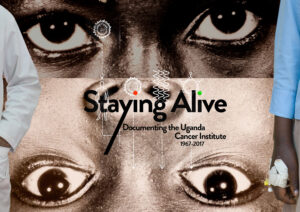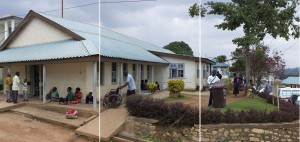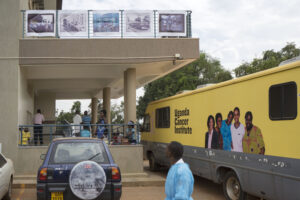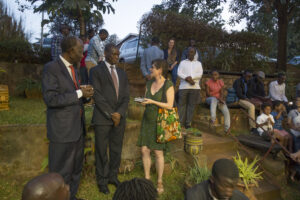Engaged Anthropology Grant: Marissa Mika

While a doctoral student at the University of Pennsylvania Marissa Mika received a Dissertation Fieldwork Grant in 2012 to aid research on “Experimental Infrastructures: Building Cancer Research in Uganda from 1950 to the Present,” supervised by Dr. Steven Feierman.” In 2017 Dr. Mika was able to follow up on her fieldwork research when she received an Engaged Anthropology Grant to aid engaged activities on “Staying Alive in Photographs at the Uganda Cancer Institute”.
In August 2017, the Uganda Cancer Institute celebrated its 50th anniversary in Kampala. Since 2010, I have worked at this site as a historian and ethnographer. My work explores the past and present of the Institute to examine how scientific research shapes biomedical care on the African continent. I focus on how experiments create and shape cultures of care that take on a political and social life of their own, well after the experiments themselves have ended. I argue that there is a fundamental dynamism to experimental sites such as the Uganda Cancer Institute. Collaborations ebb and flow according to scientific interests. Political violence forces physicians and families to flee into exile. Epidemics such as HIV transform dedicated research wards into late stage palliative care triage centers.

I started working at the Institute at a time of profound infrastructural transformation. Since the mid 2000s, political negotiations to fund better cancer services for aging Ugandans and new American interests in studying the relationship between infectious diseases and cancers in east Africa remade the Institute. Through political lobbying, vision, and USAID grants, two new cancer care facilities were built at the UCI.
These latest transformations are both creative and destructive. Drug procurement patterns, records keeping systems that have not been seriously updated since the 1960s, and ward rounds are all components of infrastructures for care that are being radically reformulated by Ugandan oncologists, nurses, laboratory, and social workers. The new UCI-Fred Hutch Cancer Centre, stands on the demolition site of the Institute’s original Lymphoma Treatment Center from the 1960s. It both ushers in a new era of research on the synergy between infectious diseases in cancer, and violently tears down over 45 years of carefully honed cancer care practices.
For the entire year I worked at the UCI, I knew the Lymphoma Treatment Center was going to be torn down to make way for a new cancer treatment center. My Wenner Gren Dissertation Fieldwork grant made it possible to trace how this experimental infrastructure was being remade in real time across multiple geographies and places. The Wenner Gren Engaged Anthropology Grant made it possible to share, publicize, and exhibit these profound transformations documented through a long-term collaborative photography project and book made with artist and researcher Andrea Stultiens. Staying Alive showcases photographs which capture continuities be they extraordinary bodily states, the physical dynamism of this experimental field, the everyday lives of patients, or the empathetic care which medical staff and families bring to the wards on a daily basis.

The book and exhibition creates a visual and historical conversation between two sets of photographs from the materials and moments that make up the Institute in the late 1960s and 2012. The first is from the personal archives of John Ziegler, the founding director of the Uganda Cancer Institute in the 1960s. These materials document major and minor events and images from around the Institute in the 1960s and early 1970s. There are snapshots of political visitors touring the wards, wildlife encountered on up country “patient safaris,” laboratory and ward facilities. The contemporary photographs are made by Andrea Stultiens. The intention was to make a series of portraits of patients, as well as a photographic portrait of the Institute as a whole through its spaces—wards, laboratories, hallways, kitchens, parking lots—and the people using them. As Stultiens says, “The images are both responses to the photographs from John Ziegler’s collection and alternative representations. People are photographed as individuals who happen to be patients or caretakers or Institute staff. Spaces are captured without anecdote or event as motivation for the production of the picture. Taken as a whole, these historical and contemporary images complement each other, and make it possible to question each other’s existence and the ethical implications of looking ‘through’ them to people and places in remote or near pasts.”

We collaborated with the Institute to amplify the history of this hospital in Uganda during its Golden Jubilee celebrations. These events engaged with a diverse range of audiences, including the Ugandan media, government officials, medical community, and wider Ugandan public. Events included the following: the UCI@50 press conference, Radio One’s Saturday morning health awareness, the Staying Alive exhibition opening at AfriArt Gallery, interviews for the UCI’s documentary, organizing and a Health Education Journalists Network Science Café on UCI’s contributions to oncological research and care in east Africa, a series of blogposts on the HIPUganda website, shared by bi-weekly newspaper The Observer, and the keynote lecture at the fiftieth Anniversary Gala Dinner for diplomats, scientific experts, and UCI staff.
The images and words in Staying Alive open up a space for conversation about continuity and change in ways that a scholarly monograph cannot. The exhibition created a space for critical institutional reflexivity about transformations in mortar and concrete, research and care. The publication and distribution of these materials in accessible photo book form also served as a vital component of research results dissementation that was timely and accessible for an audience beyond elite academic seminars or oncology conferences.
You can read more about Staying Alive and the exhibition in the series of blog posts at History in Progress Uganda: